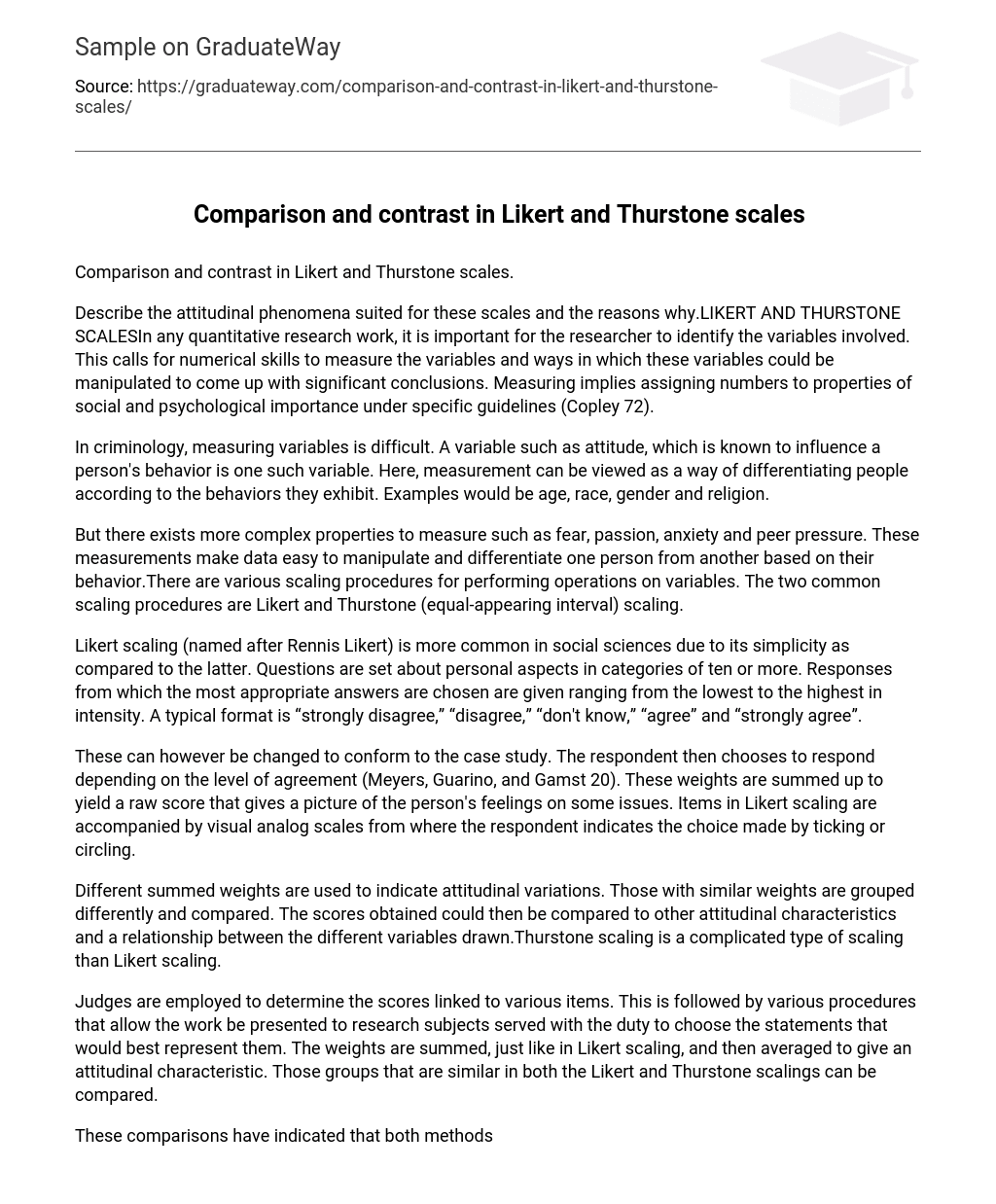Comparison and contrast in Likert and Thurstone scales.
Describe the attitudinal phenomena suited for these scales and the reasons why.LIKERT AND THURSTONE SCALESIn any quantitative research work, it is important for the researcher to identify the variables involved. This calls for numerical skills to measure the variables and ways in which these variables could be manipulated to come up with significant conclusions. Measuring implies assigning numbers to properties of social and psychological importance under specific guidelines (Copley 72).
In criminology, measuring variables is difficult. A variable such as attitude, which is known to influence a person’s behavior is one such variable. Here, measurement can be viewed as a way of differentiating people according to the behaviors they exhibit. Examples would be age, race, gender and religion.
But there exists more complex properties to measure such as fear, passion, anxiety and peer pressure. These measurements make data easy to manipulate and differentiate one person from another based on their behavior.There are various scaling procedures for performing operations on variables. The two common scaling procedures are Likert and Thurstone (equal-appearing interval) scaling.
Likert scaling (named after Rennis Likert) is more common in social sciences due to its simplicity as compared to the latter. Questions are set about personal aspects in categories of ten or more. Responses from which the most appropriate answers are chosen are given ranging from the lowest to the highest in intensity. A typical format is “strongly disagree,” “disagree,” “don’t know,” “agree” and “strongly agree”.
These can however be changed to conform to the case study. The respondent then chooses to respond depending on the level of agreement (Meyers, Guarino, and Gamst 20). These weights are summed up to yield a raw score that gives a picture of the person’s feelings on some issues. Items in Likert scaling are accompanied by visual analog scales from where the respondent indicates the choice made by ticking or circling.
Different summed weights are used to indicate attitudinal variations. Those with similar weights are grouped differently and compared. The scores obtained could then be compared to other attitudinal characteristics and a relationship between the different variables drawn.Thurstone scaling is a complicated type of scaling than Likert scaling.
Judges are employed to determine the scores linked to various items. This is followed by various procedures that allow the work be presented to research subjects served with the duty to choose the statements that would best represent them. The weights are summed, just like in Likert scaling, and then averaged to give an attitudinal characteristic. Those groups that are similar in both the Likert and Thurstone scalings can be compared.
These comparisons have indicated that both methods give similar degrees of the measured attitudes.Thus, Likert scaling is more appropriate for measuring features such as reactions and responses. These would include characteristics like how long, what effect or how often. This is because the answers are definite.
But for cases that involve indefinite answers that would require critical analysis and judgement, then Thurstone scaling is recommended. Examples of this would include people’s general response to questions or rating some performance. Whatever the method chosen, the end results should be comparable because these two scaling methods are comparable in their results.Work CitedCopley, Walt.
Criminal Justice Research Methods CJ408 Grantham Arts & Sciences Series. 3rd Edition. Grantham University, Kansa City, Mo USA. Prentice Hall, 2006.
71-74.Meyers, Lawrence S., Anthony Guarino and, Glenn Gamst. Applied Multivariate Research: Design and Interpretation.
Sage Publications Inc, 2005. 20.





